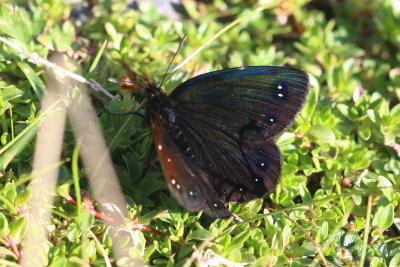
48213_female_Hautes-Pyrénées_7Jul21
48226_female_Hautes-Pyrénées_7Jul21
Lefèbvre's Ringlet (Erebia lefebvrei)
2024 photographs highlighted in yellow. Click on any photograph to go to an enlarged picture, or simply scroll down the page.
 |
||
| 51358_male_Hautes-Pyrénées_9Jul23 |
48213_female_Hautes-Pyrénées_7Jul21 |
48226_female_Hautes-Pyrénées_7Jul21 |
|
A rather rare and elusive Erebia of the high Pyrénées, at least it had eluded me for many years and 48213 from 2021 on this page was the first time I had seen one.
It is fairly readily identifiable, given that a number of other Erebia fly in company with it, by the very large ocelli (both in the male and female) that are toward the outer edge of the red post-discal band (unusually not present on the examples on this page). |
It is apparently notoriously difficult to approach as it favours rocky scree, in common with several other high altitude Erebia.
The subspecies astur has no, or limited, red post-discal band but this only flies in the Picos de Europa in the north-west of Spain. This subspecies also has reduced ocelli. It has to be said that the two on this page fit the description of astur almost perfectly, despite being far removed from the Picos. |
|
ref |
sex |
observations |
alt. m |
| 51538 | M | a male, devoid of any red post-discal band and a very good fit for the subspecies astur, giving added weight to the comments made on 48213 below. | 2070 |
|
48213 |
F |
a very unusual female in that it is uniformly black with very large
black-ringed ocelli and very large white centres. In terms of colouring, it
resembles the subspecies astur, although the ocelli are typical (I say
this on the basis of one individual plus what it shown on trusted books and
websites) of nominate lefebvrei. Either it could not be astur,
given that it was seen a very considerable distance from the Picos, or the
distribution of astur extends further north than stated. My feeling is
that the latter is more likely. I chanced upon it by pure accident when I asked someone what they were intently photographing, so an enormous thank you to YK. 48213 was motionless and open-winged in overcast conditions, settled on lichen-covered rock, but when it started to rain, it calmly closed its wings and walked a few centimetres to as spot where it was sheltered from the rain, and then closed its wings. 48226 is the underside, having taken up the sheltered position. I was subsequently informed by the local expert (JL) that it had not been seen at that locality for 20 years. |
1700 |
|
48226 |
F |
the underside of 48213. |
1700 |
51358_male_Hautes-Pyrénées_9Jul23
48213_female_Hautes-Pyrénées_7Jul21
48226_female_Hautes-Pyrénées_7Jul21